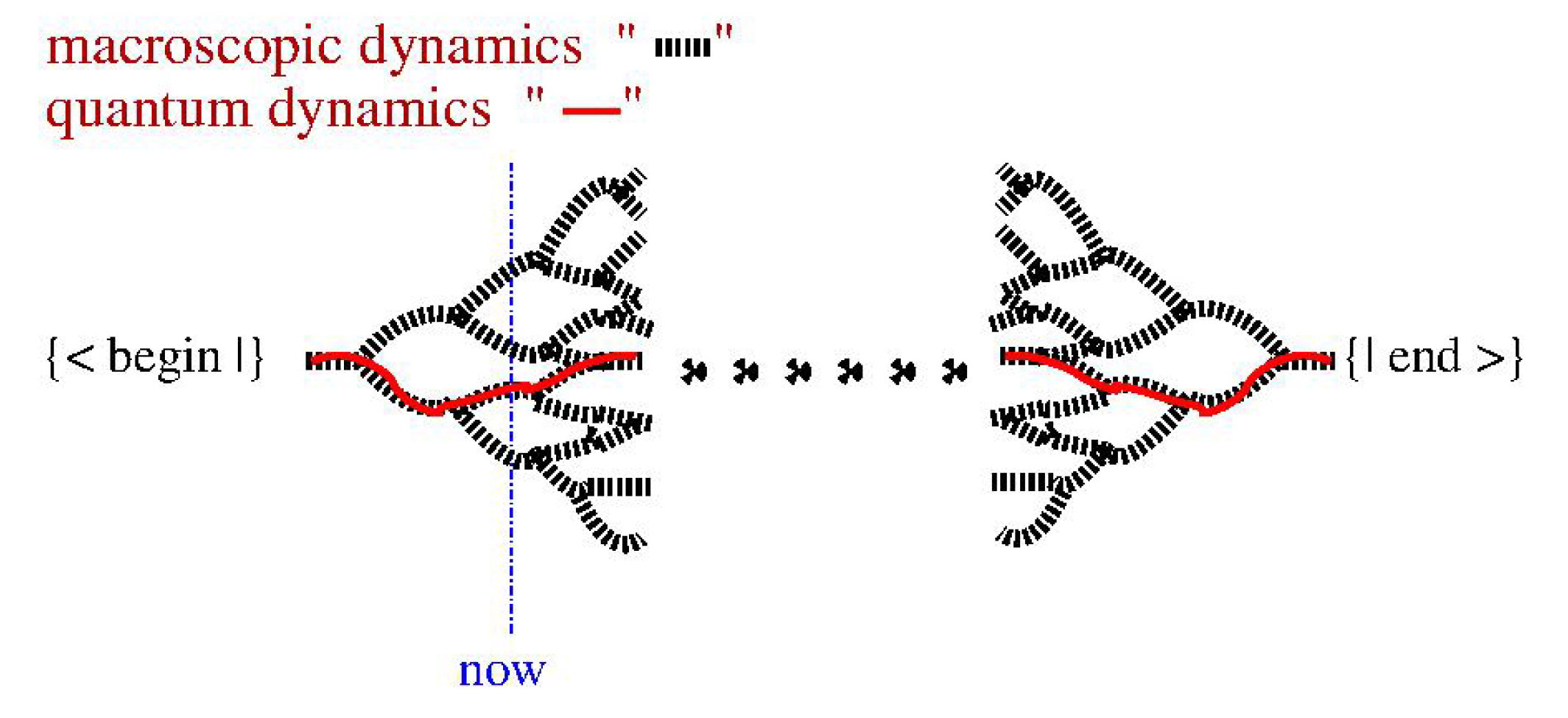How to Avoid Absolute Determinismin Two Boundary Quantum Dynamics
Abstract
1. Two Boundary Quantum Dynamics
2. The Emerging Macroscopic Dynamics
2.1. No Classical Backward Causation
2.2. The Breaking of the Time Symmetry
2.3. Consecutive Willful Decisions
3. Conclusions
Funding
Acknowledgments
Conflicts of Interest
References
- Sakurai, J.J.; Napolitano, J.J. Modern Quantum Mechanics; Pearson Higher Ed.: London, UK, 2014. [Google Scholar]
- Einstein, A.; Podolsky, B.; Rosen, N. Can quantum-mechanical description of physical reality be considered complete? Phys. Rev. 1935, 47, 777. [Google Scholar] [CrossRef]
- Wharton, K.; Argaman, N. Colloquium: Bell’s theorem and locally mediated reformulations of quantum mechanics. Rev. Mod. Phys. 2020, 92, 021002. [Google Scholar] [CrossRef]
- Evans, P.W. Retrocausality at no extra cost. Synthese 2015, 192, 1139–1155. [Google Scholar] [CrossRef]
- Leifer, M.S.; Pusey, M.F. Is a time symmetric interpretation of quantum theory possible without retrocausality? Proc. R. Soc. Math. Phys. Eng. Sci. 2017, 473, 20160607. [Google Scholar] [CrossRef]
- Rietdijk, C. Proof of a retroactive influence. Found. Phys. 1978, 8, 615–628. [Google Scholar] [CrossRef]
- Stapp, H.P. Nonlocal character of quantum theory. Am. J. Phys. 1997, 65, 300–304. [Google Scholar] [CrossRef]
- Shimony, A.; Stein, H. Comment on “Nonlocal character of quantum theory,” by Henry P. Stapp [Am. J. Phys. 65 (4), 300–304 (1997)]. Am. J. Phys. 2001, 69, 848–853. [Google Scholar] [CrossRef]
- Mermin, N.D. Nonlocal character of quantum theory? Am. J. Phys. 1998, 66, 920–924. [Google Scholar] [CrossRef]
- Vaidman, L. Quantum nonlocality. Entropy 2019, 21, 447. [Google Scholar] [CrossRef]
- Bopp, F.W. An intricate quantum statistical effect and the foundation of quantum mechanics. arXiv 2019, arXiv:1909.01391. [Google Scholar]
- Aharonov, Y.; Cohen, E.; Elitzur, A.C. Can a future choice affect a past measurement’s outcome? Ann. Phys. 2015, 355, 258–268. [Google Scholar] [CrossRef]
- Hartle, J.B. Arrows of Time and Initial and Final Conditions in the Quantum Mechanics of Closed Systems Like the Universe. arXiv 2020, arXiv:2002.07093. [Google Scholar]
- Cramer, J.G. The transactional interpretation of quantum mechanics. Rev. Mod. Phys. 1986, 58, 647. [Google Scholar] [CrossRef]
- Bopp, F.W. A Bi-directional Big Bang/Crunch Universe within a Two-State-Vector Quantum Mechanics? Found. Phys. 2019, 49, 53–62. [Google Scholar] [CrossRef]
- Bopp, F.W. Time Symmetric Quantum Mechanics and Causal Classical Physics. Found. Phys. 2017, 47, 490–504. [Google Scholar] [CrossRef]
- Bopp, F.W. Causal Classical Physics in Time Symmetric Quantum Mechanics. In Proceedings of the 4th International Electronic Conference on Entropy and Its Applications, Basel, Switzerland, 21 November–1 December 2017. [Google Scholar] [CrossRef]
- Wharton, K. Time-symmetric boundary conditions and quantum foundations. Symmetry 2010, 2, 272–283. [Google Scholar] [CrossRef]
- Aharonov, Y.; Bergmann, P.G.; Lebowitz, J.L. Time symmetry in the quantum process of measurement. Phys. Rev. 1964, 134, B1410. [Google Scholar] [CrossRef]
- Carroll, S.M.; Singh, A. Mad-Dog everettianism: Quantum mechanics at its most minimal. In What Is Fundamental? Springer: Berlin, Germany, 2019; pp. 95–104. [Google Scholar]
- Peres, A. Quantum Theory: Concepts and Methods; Springer Science & Business Media: Berlin, Germany, 2006; Volume 57. [Google Scholar]
- Sondermann, M.; Maiwald, R.; Konermann, H.; Lindlein, N.; Peschel, U.; Leuchs, G. Design of a mode converter for efficient light-atom coupling in free space. Appl. Phys. 2007, 89, 489–492. [Google Scholar] [CrossRef][Green Version]
- Hellmuth, T.; Walther, H.; Zajonc, A.; Schleich, W. Delayed-choice experiments in quantum interference. Phys. Rev. 1987, 35, 2532. [Google Scholar] [CrossRef]
- Jacques, V.; Wu, E.; Grosshans, F.; Treussart, F.; Grangier, P.; Aspect, A.; Roch, J.F. Delayed-choice test of quantum complementarity with interfering single photons. Phys. Rev. Lett. 2008, 100, 220402. [Google Scholar] [CrossRef]
- Davidson, M. On the Mössbauer Effect and the Rigid Recoil Question. Found. Phys. 2017, 47, 327–354. [Google Scholar] [CrossRef][Green Version]
- Bedingham, D.J.; Maroney, O.J. Time reversal symmetry and collapse models. Found. Phys. 2017, 47, 670–696. [Google Scholar] [CrossRef][Green Version]
- Dente, G.C. Causality in the Classical Limit for Quantum Electrodynamics. Found. Phys. 2018, 48, 628–635. [Google Scholar] [CrossRef]
- Hossenfelder, S.; Palmer, T. Rethinking superdeterminism. Front. Phys. 2020, 8, 139. [Google Scholar] [CrossRef]
- Hooft, G.T. The free-will postulate in quantum mechanics. arXiv 2007, arXiv:quant-ph/070109. [Google Scholar]
- Plenio, M.B.; Huelga, S.F. Dephasing-assisted transport: Quantum networks and biomolecules. New J. Phys. 2008, 10, 113019. [Google Scholar] [CrossRef]
- Vaidman, L. Quantum Theory and Determinism. Quant. Stud. Math. Found. 2014, 1, 5–38. [Google Scholar] [CrossRef]
- Vaidman, L. Derivations of the Born rule. In Quantum, Probability, Logic; Springer: Berlin, Germany, 2020; pp. 567–584. [Google Scholar]
- Castagnino, M.; Fortin, S.; Laura, R.; Sudarsky, D. Interpretations of quantum theory in the light of modern cosmology. Found. Phys. 2017, 47, 1387–1422. [Google Scholar] [CrossRef]
- Hartle, J.B. The Impact of Cosmology on Quantum Mechanics. arXiv 2019, arXiv:1901.03933. [Google Scholar]


© 2020 by the author. Licensee MDPI, Basel, Switzerland. This article is an open access article distributed under the terms and conditions of the Creative Commons Attribution (CC BY) license (http://creativecommons.org/licenses/by/4.0/).
Share and Cite
Bopp, F.W. How to Avoid Absolute Determinismin Two Boundary Quantum Dynamics. Quantum Rep. 2020, 2, 442-449. https://doi.org/10.3390/quantum2030030
Bopp FW. How to Avoid Absolute Determinismin Two Boundary Quantum Dynamics. Quantum Reports. 2020; 2(3):442-449. https://doi.org/10.3390/quantum2030030
Chicago/Turabian StyleBopp, Fritz W. 2020. "How to Avoid Absolute Determinismin Two Boundary Quantum Dynamics" Quantum Reports 2, no. 3: 442-449. https://doi.org/10.3390/quantum2030030
APA StyleBopp, F. W. (2020). How to Avoid Absolute Determinismin Two Boundary Quantum Dynamics. Quantum Reports, 2(3), 442-449. https://doi.org/10.3390/quantum2030030




